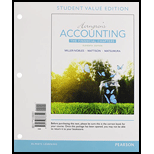
Concept explainers
Concept introduction:
Steps in Accounting cycle: Accounting cycle is the series of steps of accounting process which processes transactions into financial statements. The steps of accounting cycle are as follows:
- Collecting transactions and events
- Recording
journal entries for transactions and events - Posting the journal entries into ledgers
- Preparing unadjusted
trial balance from ledger balances - Recording
adjusting entries - Posting adjusting entries into ledgers and Preparing adjusted trial balance
- Preparing financial statements; Income statement, balances sheet, statement of owner’s equity and
Cash flow statements. - Preparing Closing entries to close temporary accounts.
- Preparing post closing trial balance
- Recording reversing journal entries (Optional)
Requirement-1:
To Prepare: The Adjusting entries for the year ended Dec. 31, 2016
Requirement-2:
To Prepare: The Adjusted Trial balance for the year ended Dec. 31, 2016
Requirement-3:
To Prepare: The Multi Step Income Statement for the year Dec. 31, 2016
Requirement-4:
To Prepare: The Statement of Owner’s Equity for the year Dec. 31, 2016
Requirement-5:
To Prepare: The Classified Balance Sheet as on Dec. 31, 2016
Want to see the full answer?
Check out a sample textbook solution
Chapter 5 Solutions
Horngren's Accounting, The Financial Chapters, Student Value Edition Plus MyLab Accounting with Pearson eText -- Access Card Package (11th Edition)
- I need assistance with this financial accounting question using appropriate principles.arrow_forwardSolve with explanation and accounting questionarrow_forwardWhen preparing the trial balance, the accountant of Zenith Co. noticed that the debit column exceeded the credit column by $1,000. Which of the following errors could cause such an imbalance? A) A transaction not recorded at all B) Reversing the debit and credit C) Posting an amount twice to the debit side D) Recording a sale as a purchase MCQarrow_forward
- What are the required sales?arrow_forwardLuma Corp. had net credit sales of $2,400,000 in 2023. The beginning accounts receivable balance was $180,000, and the ending balance was $210,000. (a) What is the receivables turnover? (b) What is the average collection period in days?arrow_forwardWhat is the desired profit for the year?arrow_forward

 AccountingAccountingISBN:9781337272094Author:WARREN, Carl S., Reeve, James M., Duchac, Jonathan E.Publisher:Cengage Learning,
AccountingAccountingISBN:9781337272094Author:WARREN, Carl S., Reeve, James M., Duchac, Jonathan E.Publisher:Cengage Learning, Accounting Information SystemsAccountingISBN:9781337619202Author:Hall, James A.Publisher:Cengage Learning,
Accounting Information SystemsAccountingISBN:9781337619202Author:Hall, James A.Publisher:Cengage Learning, Horngren's Cost Accounting: A Managerial Emphasis...AccountingISBN:9780134475585Author:Srikant M. Datar, Madhav V. RajanPublisher:PEARSON
Horngren's Cost Accounting: A Managerial Emphasis...AccountingISBN:9780134475585Author:Srikant M. Datar, Madhav V. RajanPublisher:PEARSON Intermediate AccountingAccountingISBN:9781259722660Author:J. David Spiceland, Mark W. Nelson, Wayne M ThomasPublisher:McGraw-Hill Education
Intermediate AccountingAccountingISBN:9781259722660Author:J. David Spiceland, Mark W. Nelson, Wayne M ThomasPublisher:McGraw-Hill Education Financial and Managerial AccountingAccountingISBN:9781259726705Author:John J Wild, Ken W. Shaw, Barbara Chiappetta Fundamental Accounting PrinciplesPublisher:McGraw-Hill Education
Financial and Managerial AccountingAccountingISBN:9781259726705Author:John J Wild, Ken W. Shaw, Barbara Chiappetta Fundamental Accounting PrinciplesPublisher:McGraw-Hill Education





